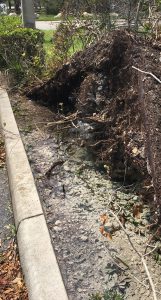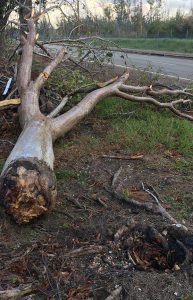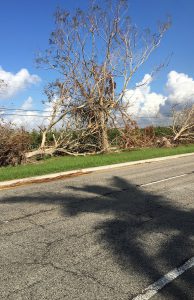When hurricane Irma hit South Florida on September 10, we did not know what to expect. After the devastation, many of us suffered loss of power, damage to buildings, and lots of tree damage. How much tree canopy was lost? We don’t know the exact number, but I can assure you that it was a large amount. Why did this happen? Is this normal to occur in every storm or hurricane to lose so much canopy? The answer is not simple, but I believe it was due to a combination of factors:
- The type of tree plays a roll. Many mahoganies, Swietenia mahagoni; sea grapes, Coccoloba uvifera; silver buttonwood, Conocarpus erectus var. sericeus; ficus, Ficus spp.; copperpod, Peltophorum pterocarpum; wild tamarind, Lysiloma latisiliquum; royal poinciana, Delonix regia; pongam, Pongamia pinnata; black olive, Bucida buceras; cassia, Cassia suratensis; Hong Kong orchid, Bauhinia x blakeana; tabebuia, Tabebuias spp. and others performed poorly. Some others like bald cypress, Taxodium distichum; live oak, Quercus virginiana; dahoon holly, Ilex cassine; royal palm, Roystonea elata; ironwood, Krugeodendrum ferrum; sabal palm, Sabal palmetto; pigeon plum, Coccoloba diversifolia; stoppers, Eugenia spp.; and others performed better. These were observations made by myself and other colleagues and not the result of detailed research.
- Soil volume was important. Trees that were planted in a restricted and limited soil space like in between a sidewalk and a road performed worse than trees located in open spaces. Soil volume is the main factor in good root support.

Limited root space and compact soils don’t allow roots systems to develop - Drainage was very important. Unfortunately, the physical characteristics of our urban soil is poor. Many times, the soil is so compacted and the drainage is so poor that the roots can barely go down at all. It was depressing for me to see 40 to 50-year-old trees with only a 1 to 2 foot deep root system. The trees that toppled revealed a root pancake under the surface.
- The quality of the root system makes a huge difference. Many uprooted trees had circling and girdling roots. It is extremely important for trees to develop a good root support system. Unfortunately, if trees were planted with circling roots, they don’t have the capacity to fix the problem. Trees graded Florida #1 are going to survive better for the next hurricane as their roots will not be girdled.
- Maintenance is key. Many co-dominant trunks split at the weak point, and this is not a surprise. Species like mahoganies, cassias, black olives, wild tamarind, sea grapes and others require a lot of structural pruning. At least one pruning every 24 months. If the trees don’t get that pruning, they are far more likely to develop poor branching architecture.

Top heavy Copperpod tree, Peltophorum pterocarpum with not pruning - Trees are better protected when they are together. When the space is available, trees should be planted in groups in order to resist the wind better.
As you can see, there are many variables that come to play when answering the question of why so many trees fell down. Selecting the wrong species of tree, with a bad quality root system in restricted, compacted soil with bad drainage, followed by no maintenance are all the ingredients you need for disaster. I know we can do better. Quality planting is more important that quantity. We can do this one tree at a time. Let’s get that canopy back Miami and be ready for the 2018 hurricane season!
 0
0




